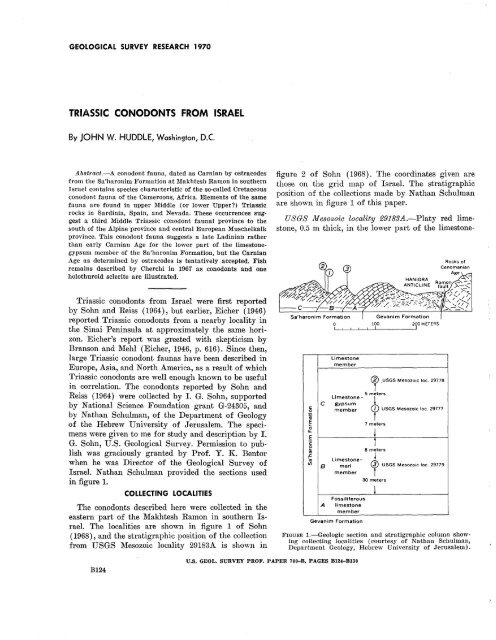RESEARCH· ·1970·
RESEARCH· ·1970·
RESEARCH· ·1970·
Create successful ePaper yourself
Turn your PDF publications into a flip-book with our unique Google optimized e-Paper software.
GE~OLOGICAL SURVEY RESEARCH 1970<br />
TRIASSIC CONODONTS FROM ISRAEL<br />
By JOHN W. HUDDLE, Washington, D.C.<br />
Abstract.-A conodont fauna, dated as Carnian by ostracodes<br />
from the Sa'haronim }!"'ormation at Makhtesh Ramon in southern<br />
Israel contains species characteristic of the so-called Cretaceous<br />
conodont fauna of the Cameroons, Africa. Elements of the same<br />
fauna are found in upper Middle (or lower Upper?) Triassic<br />
rocl\:S in Sardinia, Spain, and Nevada. These occurrences suggest<br />
a third Middle Triassic conodont faunal province to the<br />
south of the Alpine province and central European Muschelkalk<br />
province. This conodont fauna suggests a late Ladinian rather<br />
than early Carnian Age for the lower part of the limestonegypsum<br />
member of the Sa'haronim Formation, but the Carnian<br />
Age as determined by ostracodes is tentatively accepted. Fish<br />
remains described by Cherchi in 1967 as conodonts and one<br />
holothuroid sclerite are illustrated.<br />
figure 2 of Sohn (1968). The coordinates given are<br />
those on the grid map of Israel. The stratigraphic<br />
position of the collections made by Nathan Schulman<br />
are shown in figure 1 of this paper.<br />
Rocks of<br />
Triassic conodonts from Israel were first reported<br />
by Sohn and Reiss (1964), but earlier, Eicher (1946)<br />
reported Triassic conodonts from a nearby locality in<br />
the Sinai Peninsula at approximately the same horizon.<br />
Eicher's report was greeted with skepticism by<br />
Branson and l\1ehl (Eicher, 1946, p. 616). Since then,<br />
large Triassic conodont faunas have been described in<br />
E\lrope, Asia, and North America, as a result of which<br />
Triassic conodonts are well enough known to be useful<br />
in correlation. The conodonts reported by Sohn and<br />
Reiss (1964) were collected by I. G. Sohn, supported<br />
by National Science Foundation grant G-24305, and<br />
by Nathan Schulman, of the Department of Geology<br />
of the Hebrew University of Jerusalem. The specimens<br />
were given to 1ne for study and description by I.<br />
G. Sohn, U.S. Geological Survey. Permission to publish<br />
was graciously granted by Prof. Y. 1{. Bentor<br />
when he was Director of the Geological Survey of<br />
Israel. Nathan Schulman provided the sections used<br />
in figure 1.<br />
COLLECTING LOCAliTIES<br />
The conodonts described here were collected in the<br />
eastern part of the Makhtesh Ramon in southern Israel.<br />
The localities are shown in figure 1 of Sohn<br />
( 1968), and the stratigraphic position of the collection<br />
from USGS l\1esozoic locality 29183A is shown in<br />
c:<br />
0<br />
:;;<br />
til<br />
E<br />
0<br />
u..<br />
E<br />
·c:<br />
e<br />
til<br />
.c<br />
.til<br />
B<br />
Limestone-<br />
marl ~ USGS Mesozoic loc. 29779<br />
member<br />
en<br />
Gevanim Formation<br />
0 100 200 METERS<br />
Limestone<br />
member<br />
~,USGS Mesozoic loc. 29778<br />
Limestone- 5 meters<br />
member<br />
USGS M .. o,ol< lo
















